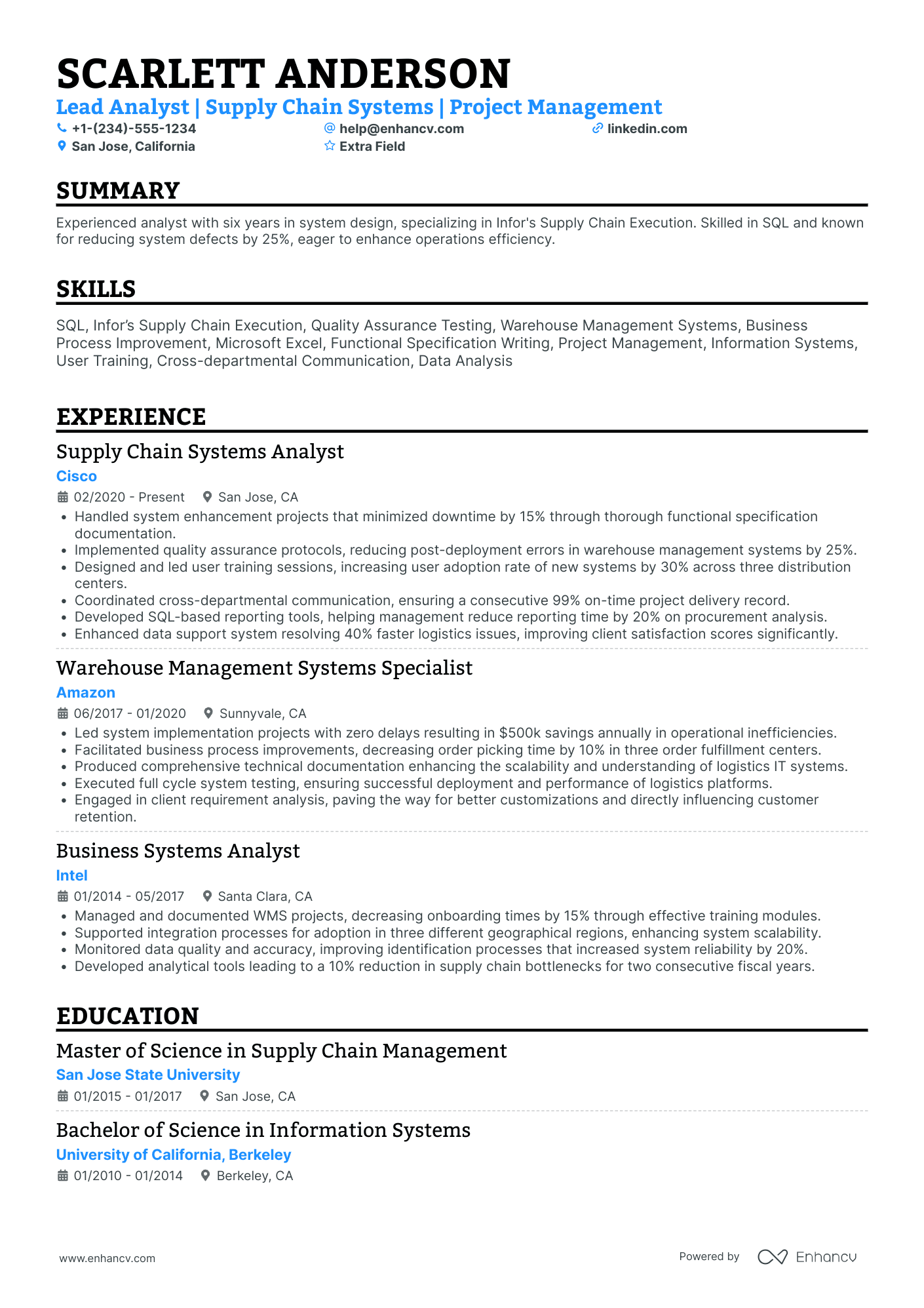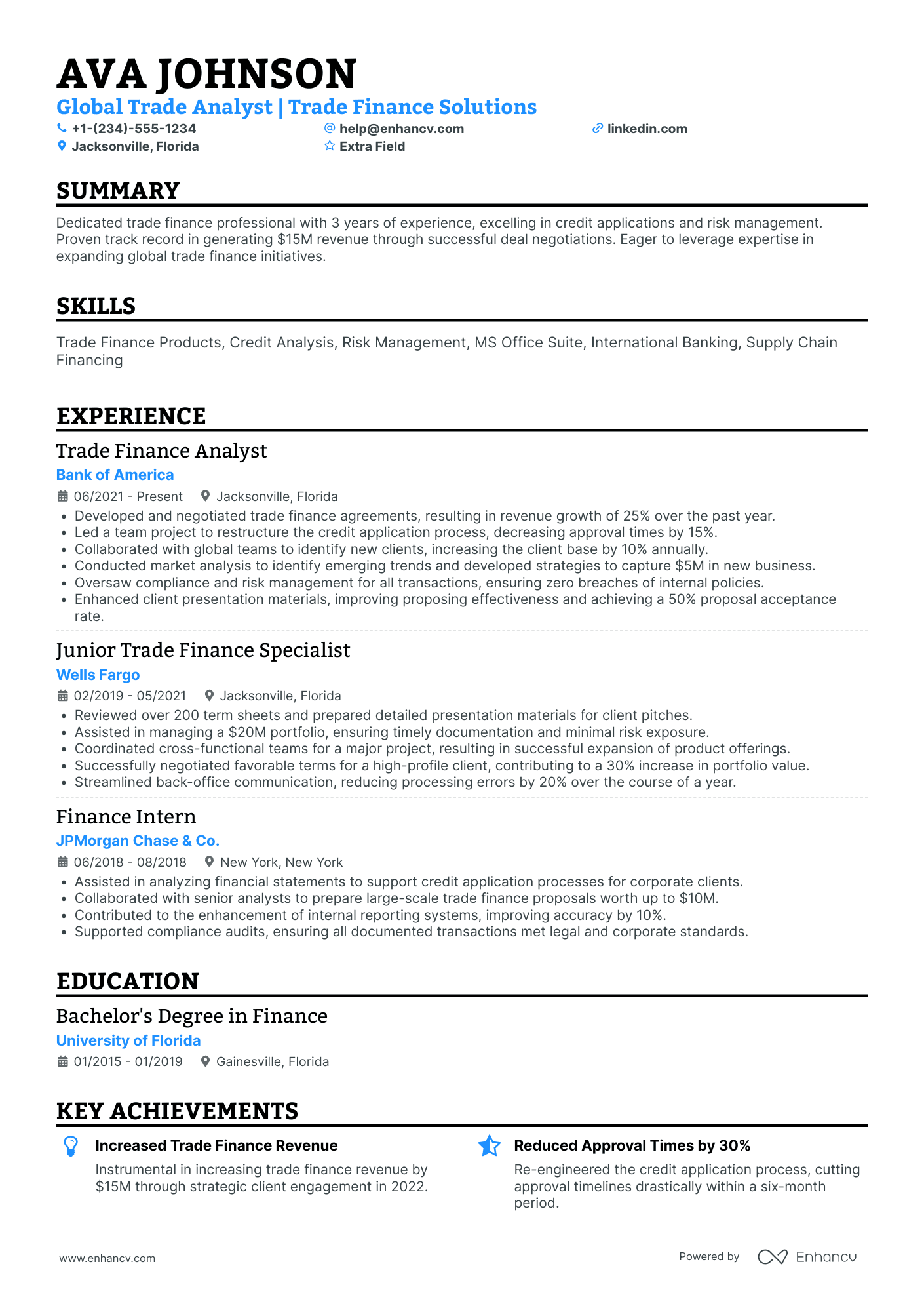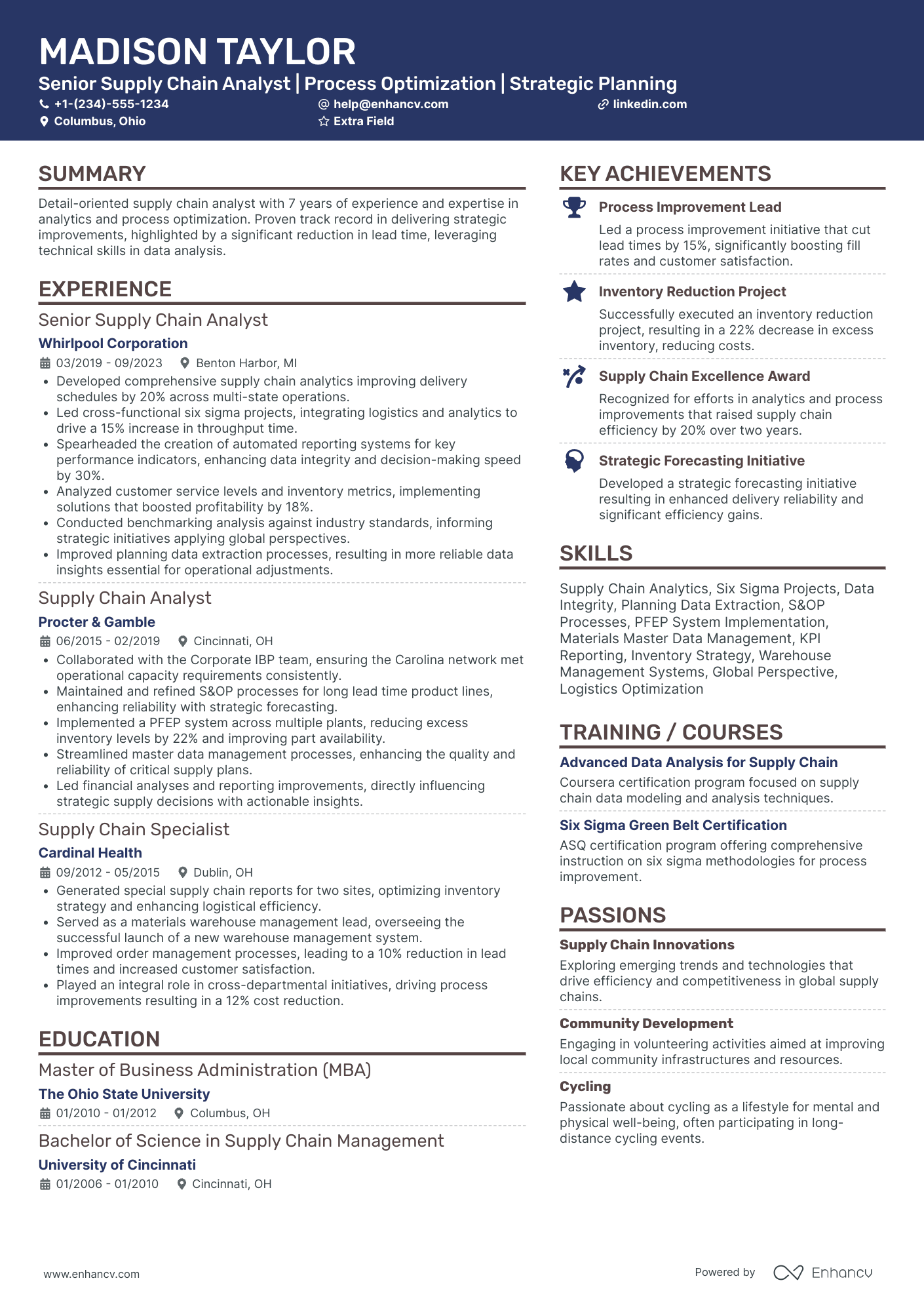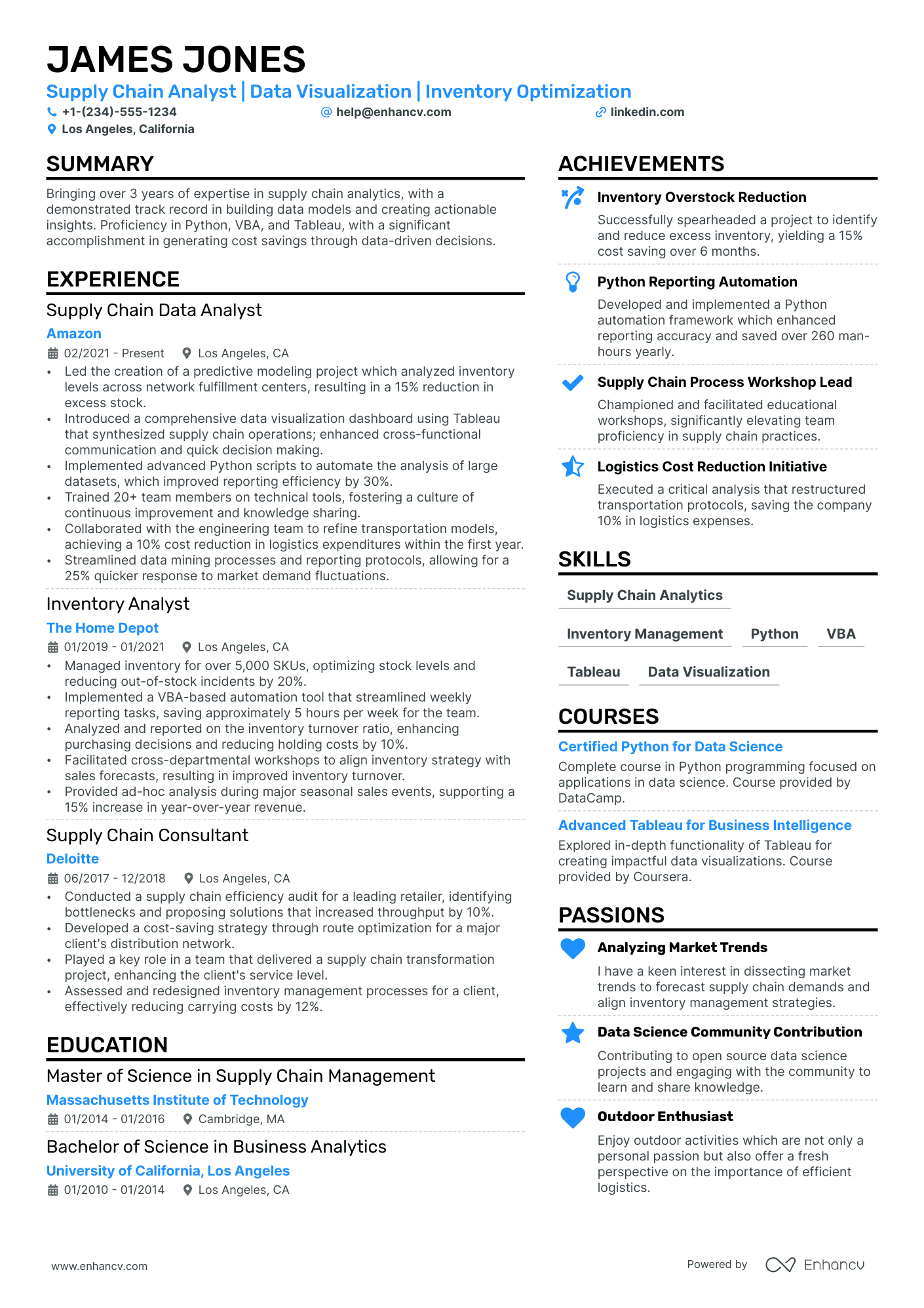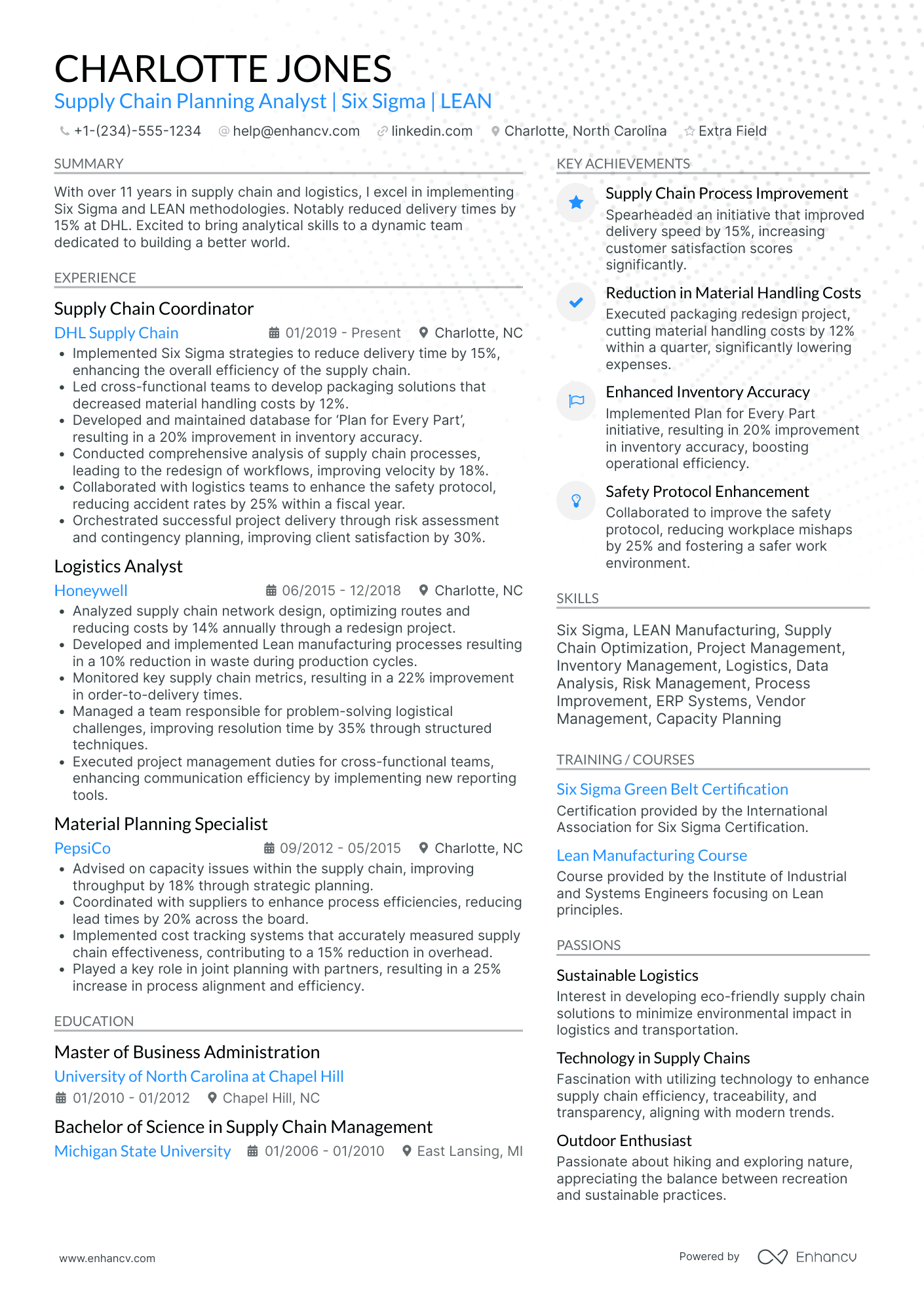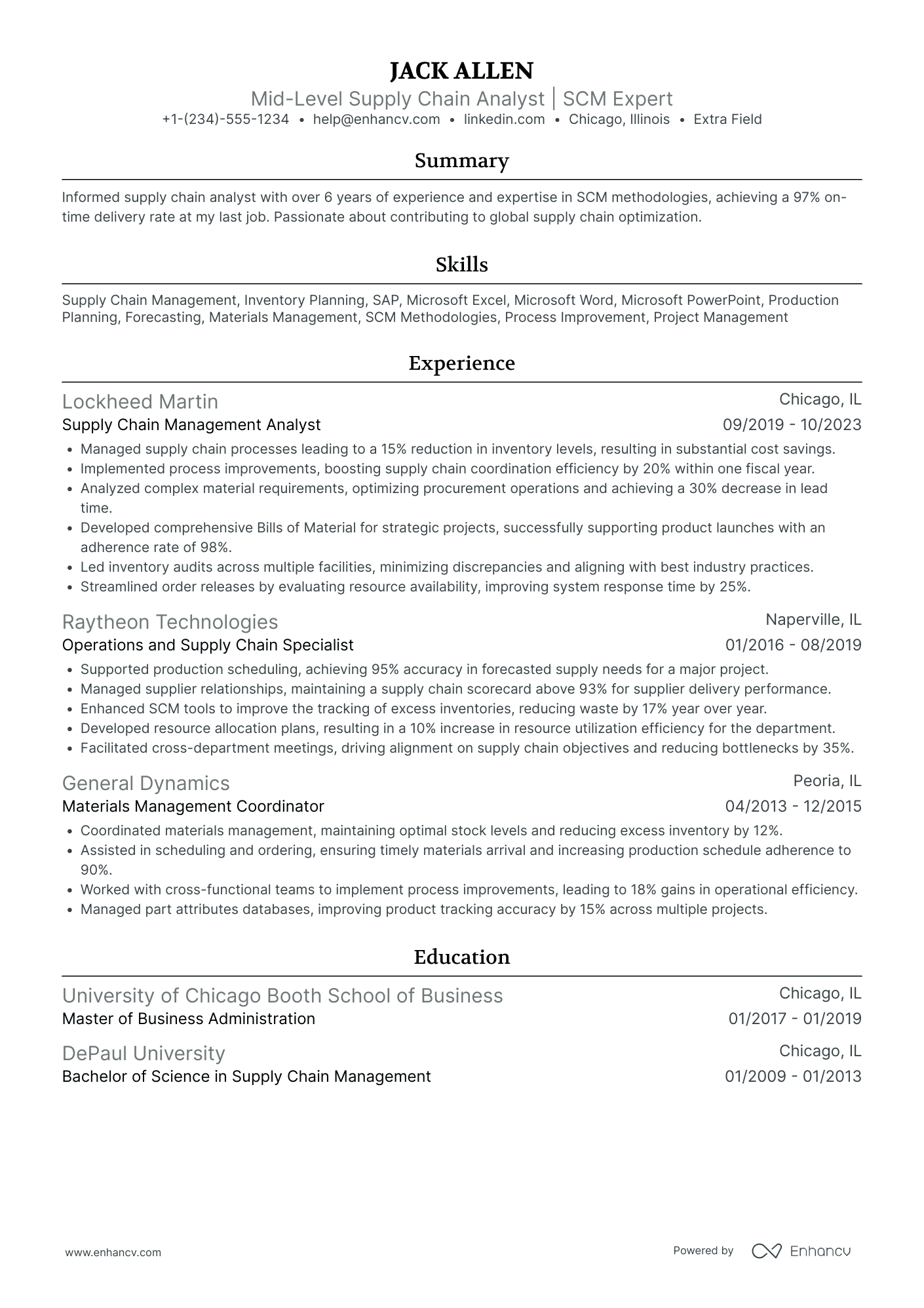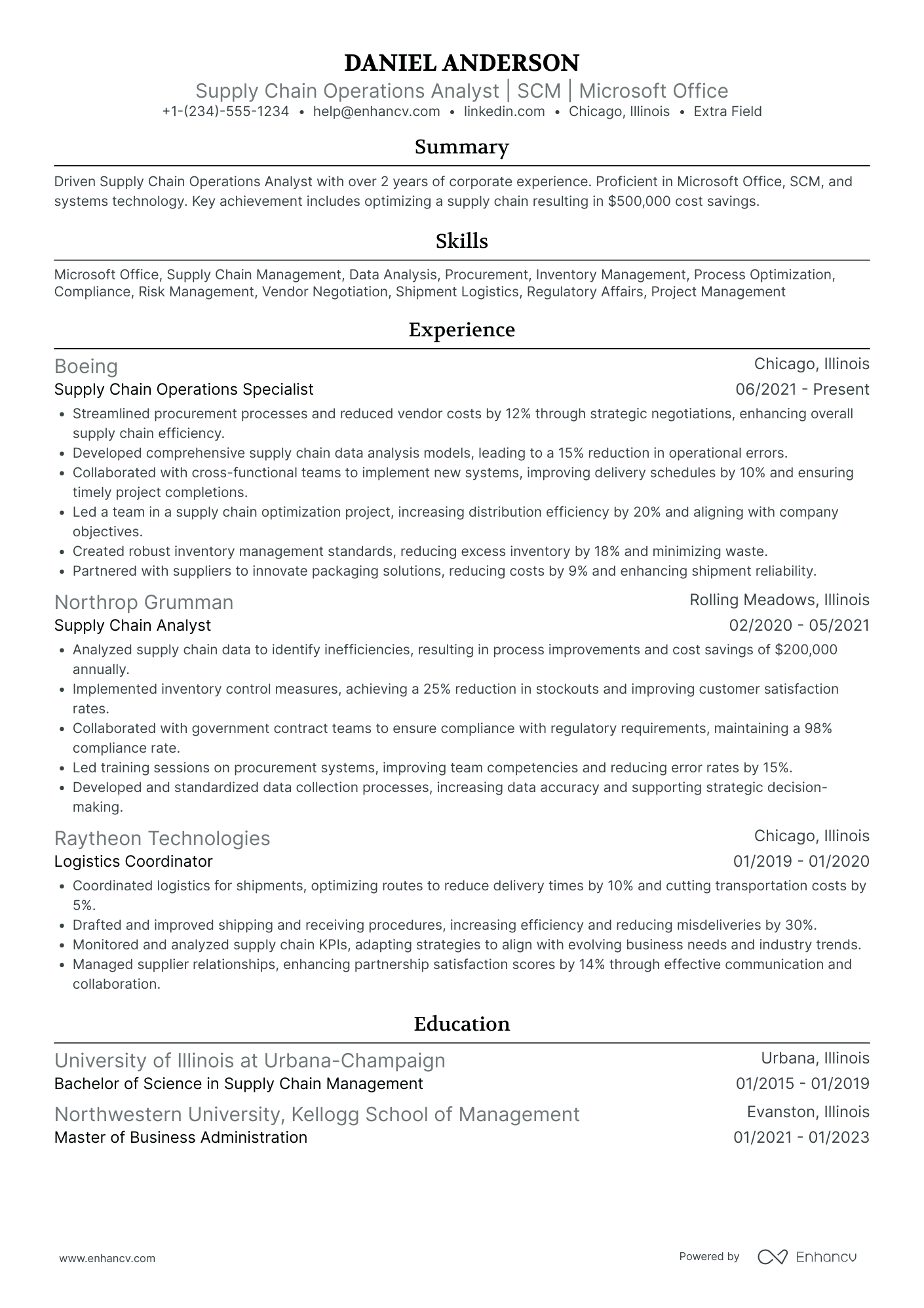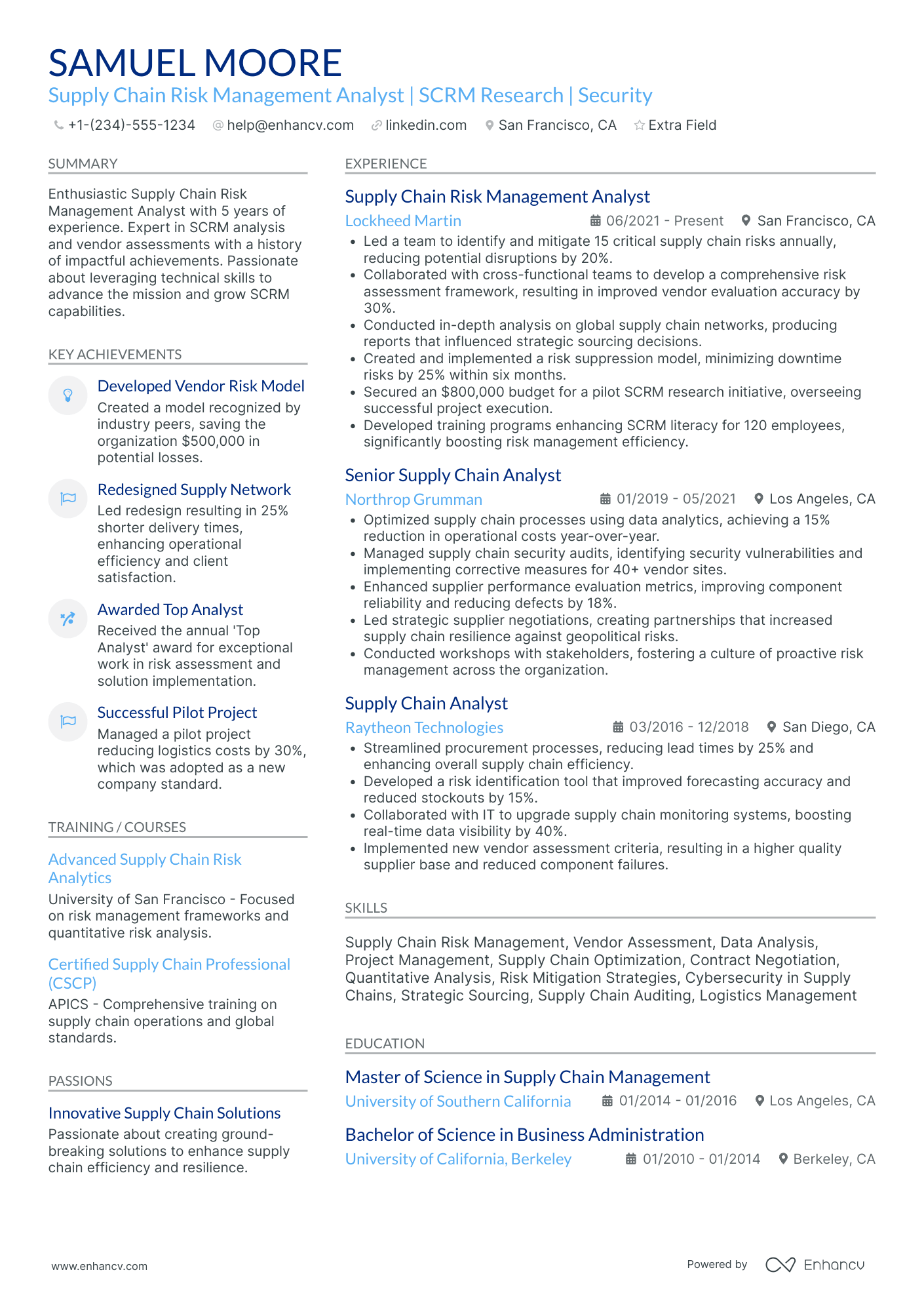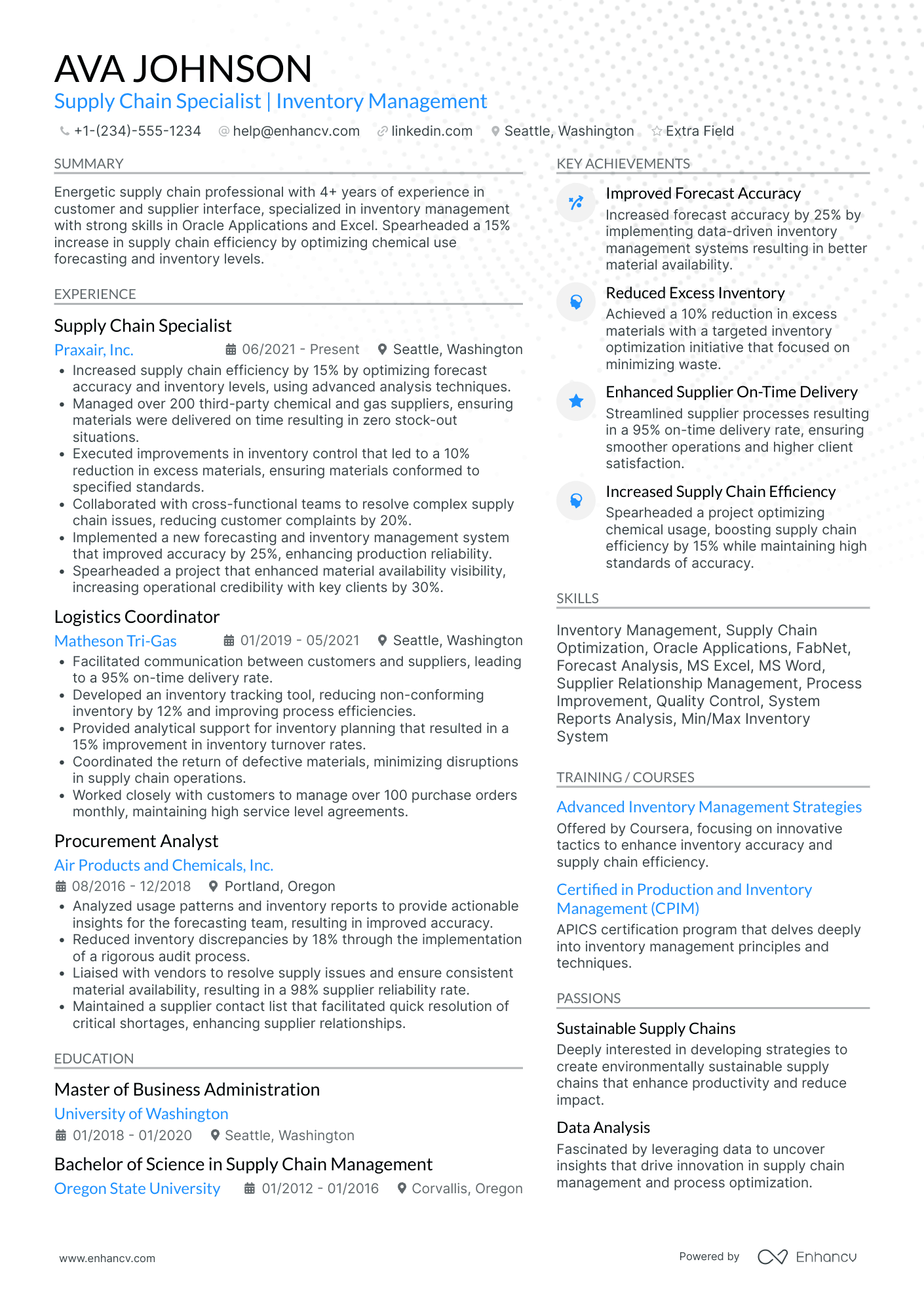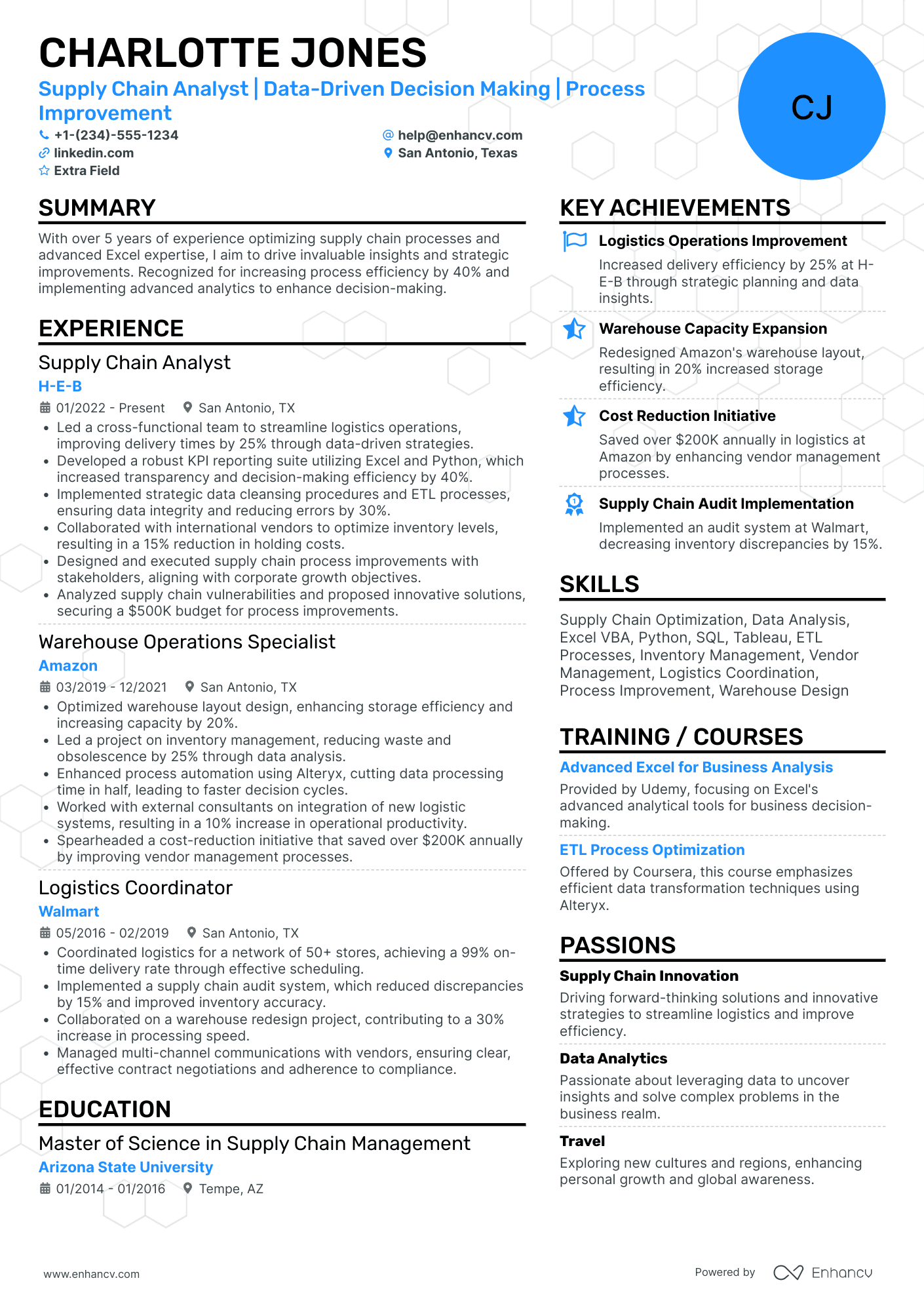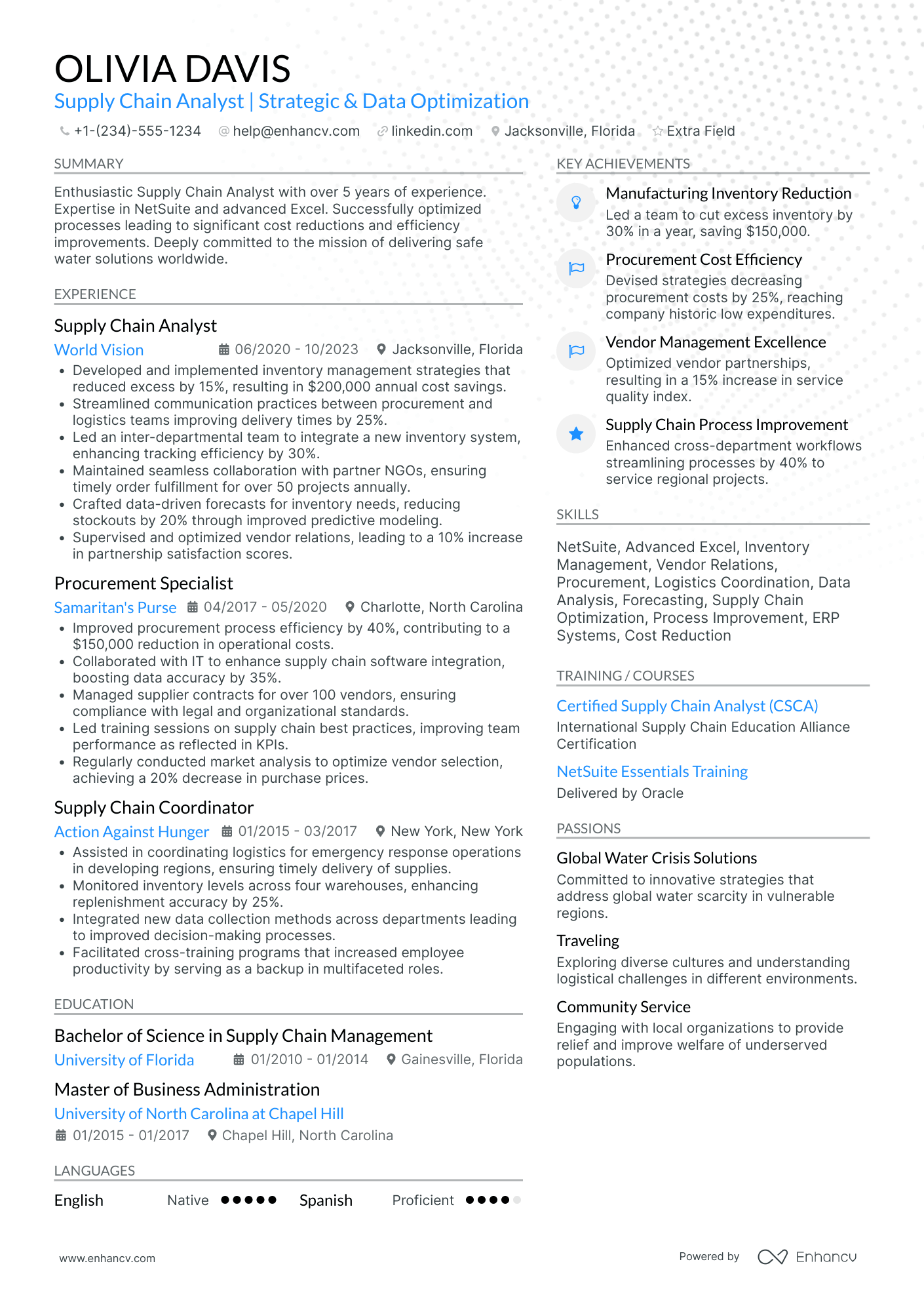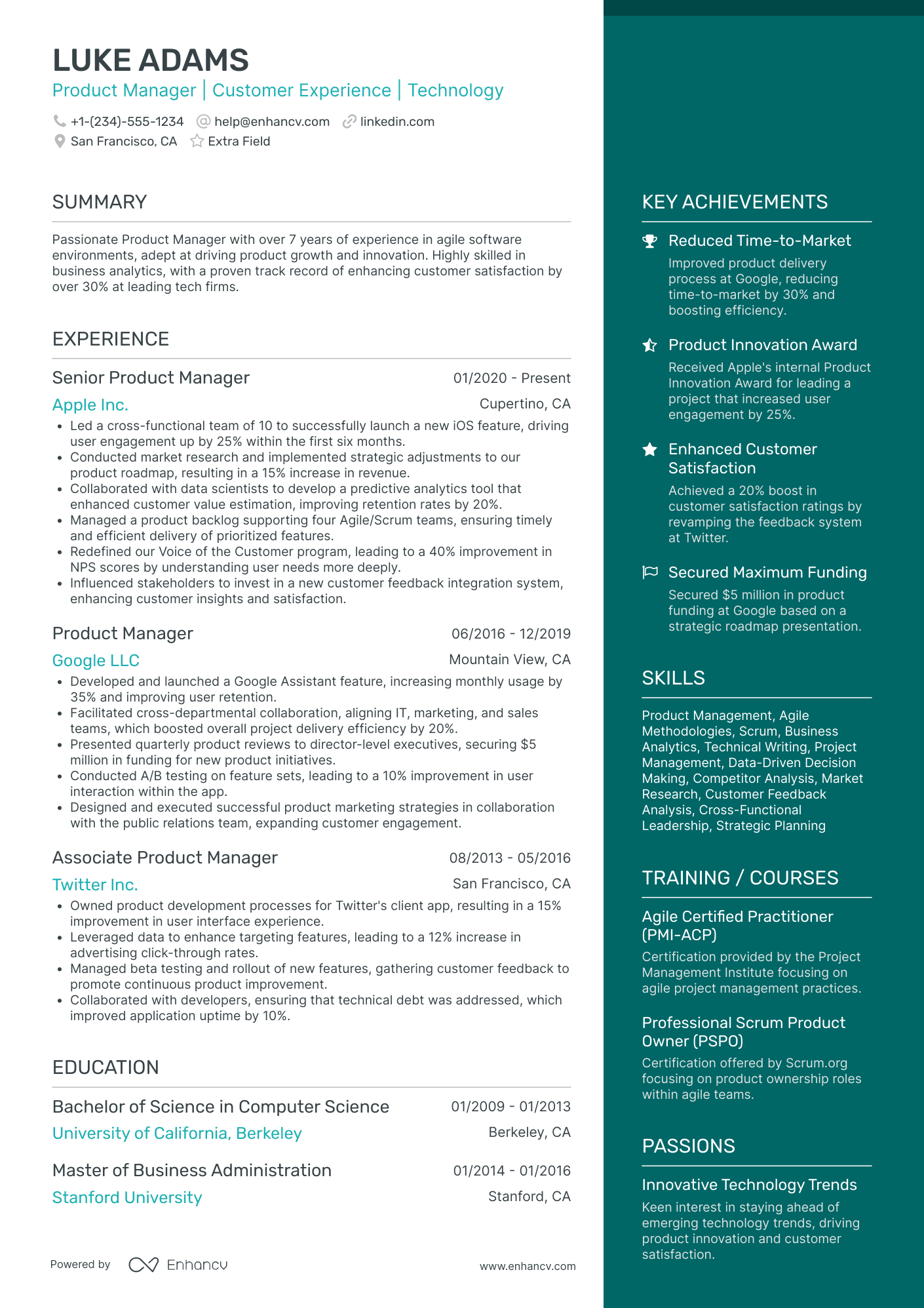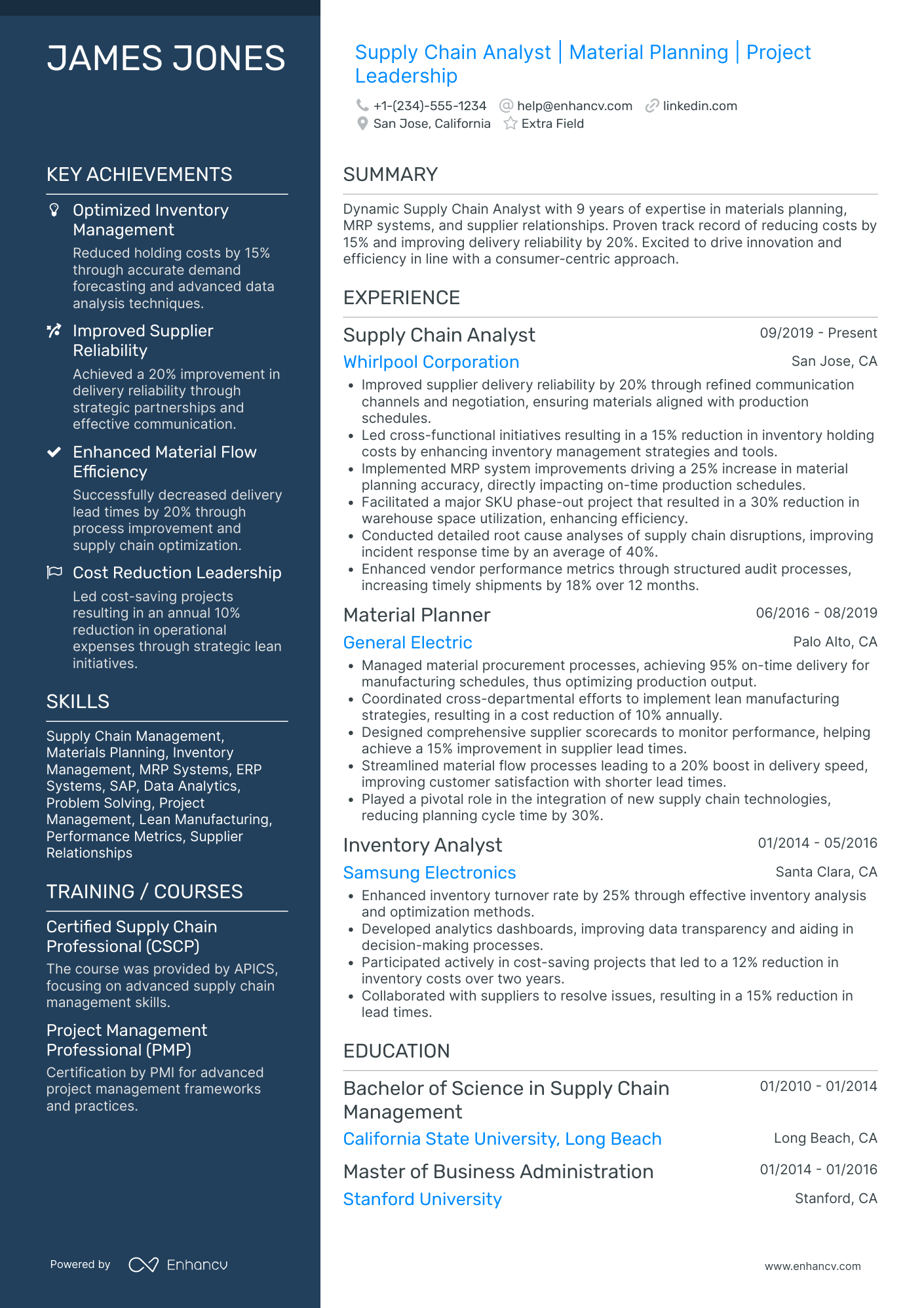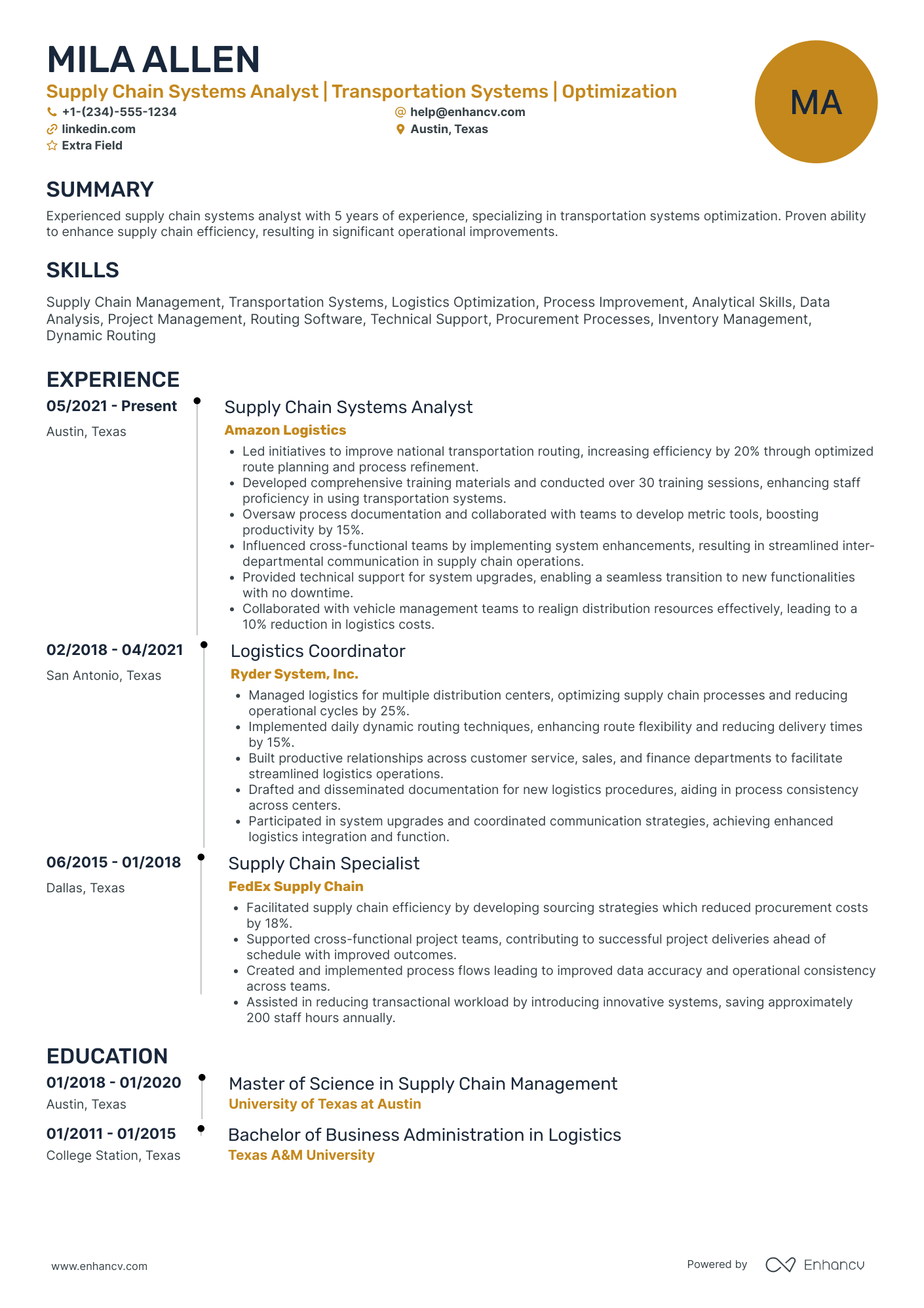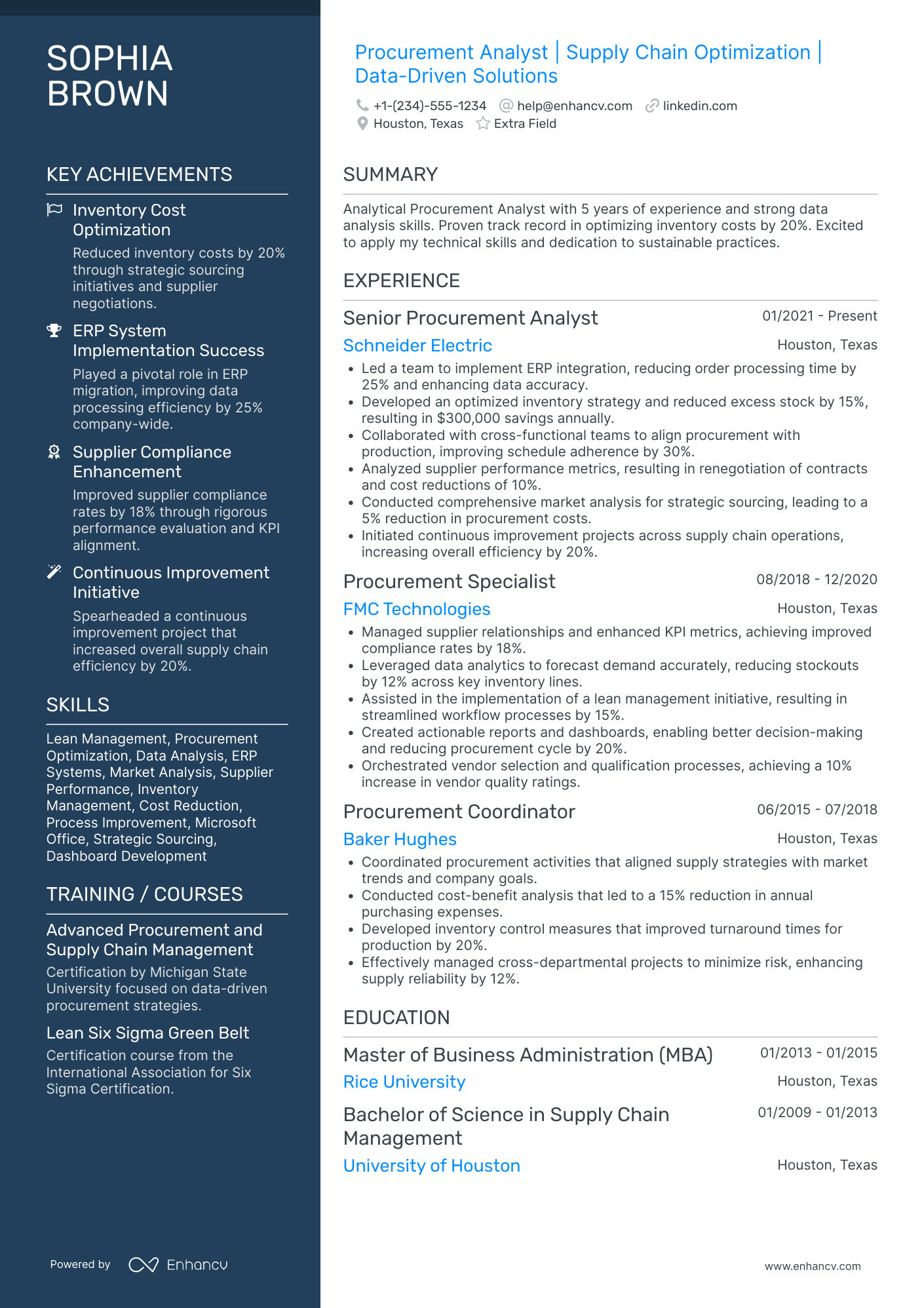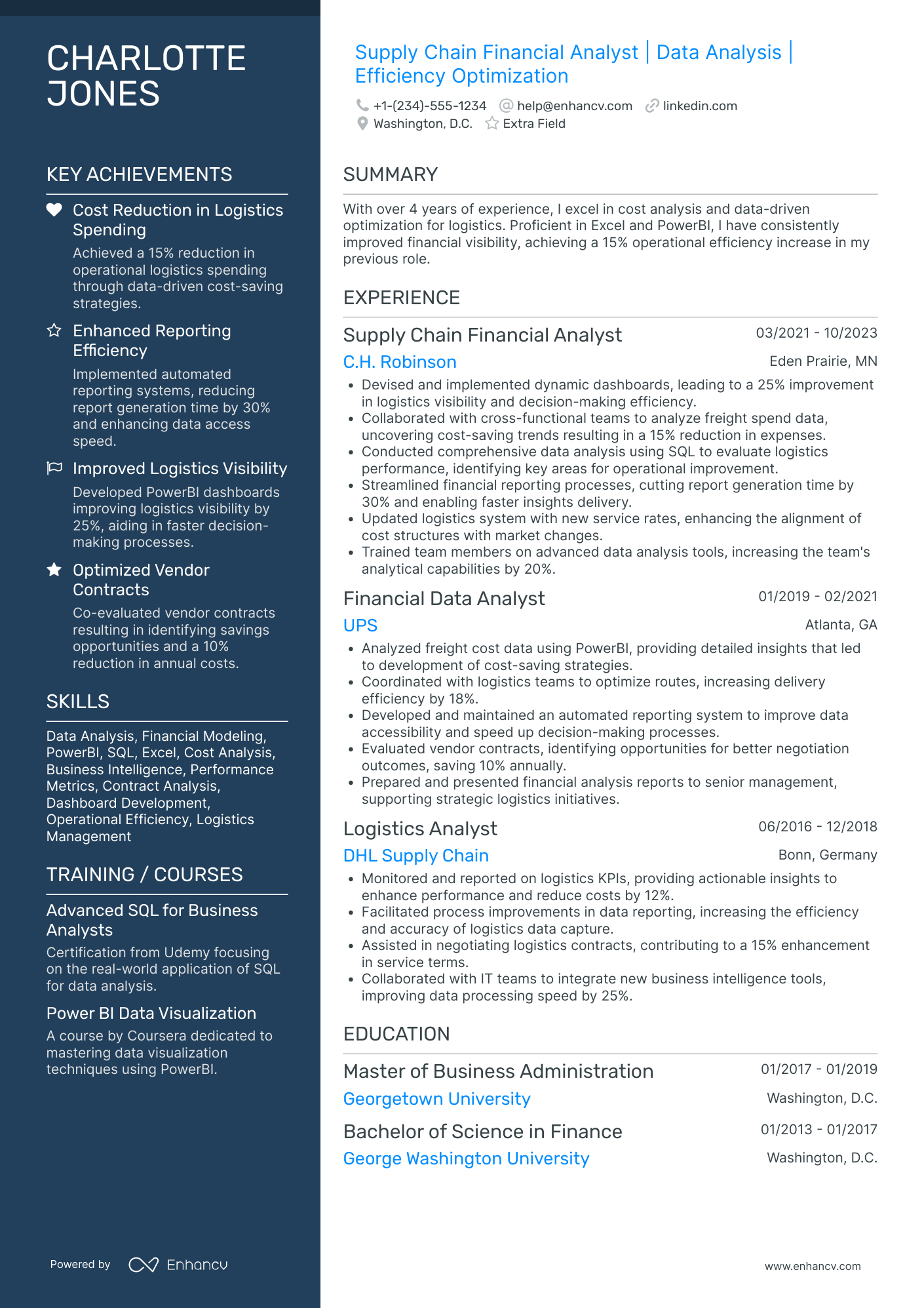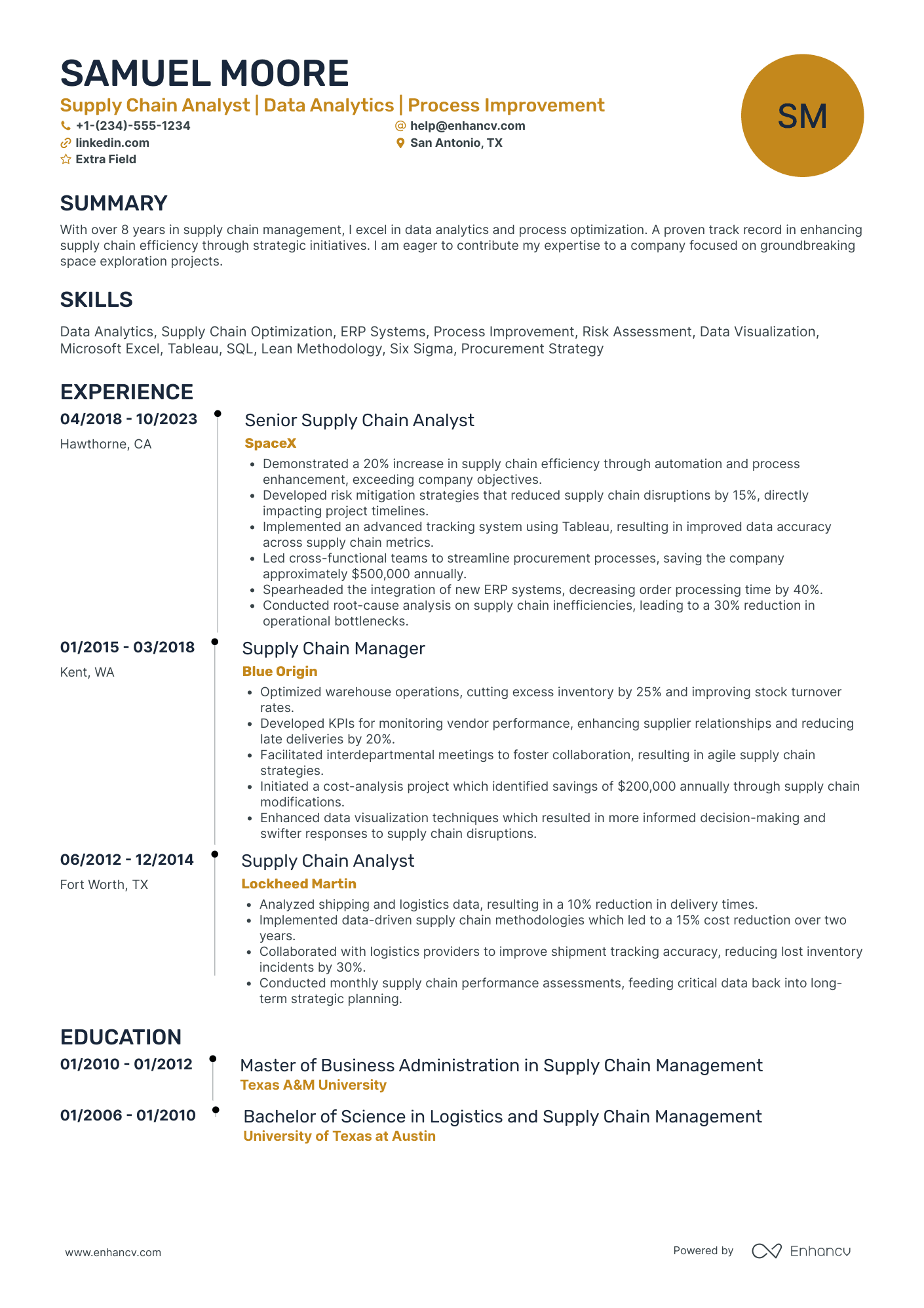Can we talk about your supply chain analyst resume?
You’ve applied to hundreds of job offers, but none resulted in a call.
What did you do wrong?
Does your resume prove you’ve got a good understanding of company’s ERP and BI applications?
Headhunters are looking for your value proposition through results. Just a handful of resumes show them the numbers. Did you build your resume around results?
Those are just some of the aspects that make up a great supply chain analyst resumes.
In reality, recruiters will spend no more than 6 seconds evaluating if you’re worth their time. It takes a lot to convince them.
Luckily, we’ve compiled the guide below with real-life resume examples and tips from the industry.
Let’s see what it takes to make a 10/10 resume.
What will you learn from this supply chain analyst resume?
- What makes a winning resume layout and how to pick yours;
- Techniques to make a skill section bring real impact;
- How to replace simple job duties with your value proposition using numbers and results;
- What exactly do employers seek in Entry-Level Supply Chain resumes;
- Examples of real resumes that got people hired;
How to write supply chain analyst resume
The #1 goal of your resume is to get you an interview.
You are not supposed to describe in minute detail what you’ve done for every job.
Senior supply chain analysts tend to send resumes stacks of long paragraphs, featuring every single task from developing performance reports to monitoring contract compliance.
Yet they fail to mention critical information, such as how they improved the top & bottom lines of an organization. Or forget to quantify results, e.g. size and scope of Distribution centre.
Whereas Entry Level supply chain analysts tend to make resumes where core skills are fleetingly mentioned, without relating them to real use cases.
What that tells you is that not everyone knows how to structure their resume properly and what sections have to be present.
6 Sections That Make a Perfect supply chain analyst Resume
- Resume header
- Professional experience
- Skills and certifications
- Big career highlights
- Resume summary or objective
- Education section
Let’s now go over the top resume format that will make those sections stand out.
What should be your primary choice for resume layout?
You should know that there are three main format types most people choose when writing resumes:
- Reverse Chronological resume layout - popular and secure choice by companies and professionals alike. You work experience, starting from the most recent one, takes a central role in the document.
- Functional resume format - least popular and not well accepted in the HR community. It is entirely focused on skills and job functions without any previous employer information.
- Hybrid resume format - stands out with the best features of both reverse-chronological and functional resumes.
If you have consistent job history in Supply Chain industry and you are simply looking forward to advance in your career, you can go with reverse-chronological format.
If you are making an effort to change careers or industries and you aim to showcase your transferable skills, a hybrid resume format is the best way to go.
Simple tactic to perfect your supply chain resume header
Countless resumes get a seemingly simple section wrong.
Your header is here to set the tone of the entire resume.
It must be short, precise and filled with important elements that your potential employer wants to see:
- Your name (not initials, full first and family name).
- Professional credentials/Current Job Title (you can list those under your name, e.g. CPM, CSCP, CPIM supply chain analyst).
- Home Address (Home city + state is enough).
- Personal email address (make sure it looks professional).
- Personal phone number (make sure your home answering message is professional).
- A link to your LinkedIn profile (the best place for a link is in your header section).
Let’s take a look at two headers and see what makes one better than the other.
The second resume header example stands out with crisp looking job title, contact data and a springboard link to its owner’s LinkedIn profile.
A job well-done that just made the recruiter happy.
Let’s continue and build the next section.
How to make your supply chain resume summary work for you
Do you have several years of experience in the field?
Then your resume can benefit from a keyword-rich resume summary of qualifications, skills and big career highlights.
When it comes to Supply Chain resume summaries, you’d ideally want to feature:
- Functional keywords, including Warehousing, S&OP, Procurement, Logistics, Sourcing;
- Your experience with SAP, Oracle or other Warehouse Management Systems;
- What soft skills you possess (leadership, change agent, etc.).
- At least one big career achievement you want to impress with (e.g. Reduced inventory levels from $42 mil to $27 mil in 2 years.)
This way, the recruiter will be able to have a quick glance at your core set of skills and what value you will bring to the company.
Pro tip
To stand out from the crowd, you can rename your Professional Summary section to one of the many other appropriate options, like "Summary of Qualifications, "Background Summary", "Professional Profile" or "Career Summary".
Time to look at two different supply chain analyst resume summaries and briefly analyze them.
Optimize your resume summary and objective for ATS
Drop your resume here or choose a file.
PDF & DOCX only. Max 2MB file size.
2 supply chain analyst resume samples
Let’s give credit where credit is due.
The second resume makes a great use of owner’s qualifications and experience. Recruiters will know who you are and what you’ve done to come this far.
But what if you’ve got less of a work experience on your plate?
Entry-level supply chain analyst resume objective writing tips
Resume objectives are more appropriate for candidates fresh out of college or just entering the field of Supply Chain industry.
The ideal resume objective packs in:
- Basic info on who you are as a pro and what are you goals. Make it concise.
- Personal statement from your own experience - avoid bland buzzwords.
- Quick highlight of your core skills and unique value proposition.
Here are a couple of examples done right and wrong to illustrate the points above.
2 entry level supply chain analyst resume objective examples
The second example is specific and addresses the job you’re applying for.
It checks off on every point without sounding too confident.
The mention of a quantifiable real-life experience gives it an upper-hand.
How to write a supply chain analyst resume experience section that will score you an interview
Now we came to the so-called "meat" of your resume.
Here is where winners get separated from losers, the resume experience section.
Let’s imagine there are two candidates. Both have a value proposition that matches the company they apply for.
But one of them presented it better.
Guess who’s going to the interview and whose resume ended up in the bin?
The one who demonstrated:
- Significant and relevant accomplishments that wow-ed the recruiter.
- Insight into the size and scope of their work (e.g. number of employees managed in a plant or the size of warehouse managed).
- Action statements in bullet format with quantifiable results.
Pro tip
Size of the previous company is an important factor to mention on your resume. Larger companies have more trading partners and nodes which results in massive data.
Look at the below practical examples to see what we mean.
Supply chain analyst resume experience examples
- •Performed cost analysis of resources and monitored their market value change.
- •Did several projects on packaging, labels & insulation for various suppliers.
- •Liaised with international clients to manage goods.
- •Reduced delivery delay.
What’s wrong here?
It’s just a list of your job duties and responsibilities.
Any accomplishments have been left out.
You won’t be able to tip the recruiters what value you brought to your previous employers.
So, it’s a clear decision - moving on to the next resume.
- •Performed 8K+ cost analysis of resources utilized by monitoring their market value change.
- •Successfully completed 3 regionalization projects for packaging, labels & insulation for Mexico suppliers.
- •Liaised with 3PL in Belgium to manage finished goods and fulfillment for all international customers.
- •Delivery delay reduced by 97% (from avg 30dd to 1d per product)
Here, recruiters can easily scan through the candidate job duties. They are coupled with results which make them fit for the position.
Pro tip
Make sure to explain the value you delivered by using numbers whenever possible. Budget figures, percentages and dollar savings look impressive on resumes - but be prepared to back them up at the interview.
How to position your experience and skills as an Entry-Level supply chain analyst
Just simply follow the tips below:
- Did you take a CSCP or an APICS membership? Follow their networking events and presentations to demonstrate you are in a field of constant learning and networking.
- Find a mentor. They would be happy to introduce you to their own contacts.
- Mention any volunteering experience you had. It demonstrates you are well-rounded and you can apply newly learned skills first hand. Easily noticeable by employers.
- Research your chosen area of supply chain and get to know the technologies they are using. You can mention your time invested in learning these in a Passions/Proud of section.
What’s more, supply chain is about 50% data analysis and 50% project management.
The latter can be dubbed as transferable.
Did you run a club or a student organisation at university?
Talk about that in your resume.
How to talk about education, training, and certifications on your resume
The Association for Operation Management’s (APICS) 2018 report on Supply Chain Careers stated that people with at least one SCM certificate get paid on average 19% more than those who are not certified at all.
The study further mentions that salaries of people with two or three certifications are 50% higher than the average for the sector.
Certificates in Supply Chain analysis and management are not required by any chance.
However, they demonstrate your broad knowledge of logistics and professional competence.
Not to mention that project management certs, such as Six Sigma can round out your resume and give advantage over the competition.
Here are 10 supply chain analysis & management certifications to lift off your career in SCM
- The Certified Supply Chain Professional - CSCP (Offered by APICS)
- APICS Certified in Production and Inventory Management (CPIM)
- APICS Certified in Logistics, Transportation & Distribution (CLTD)
- APICS Supply Chain Operations Reference (SCOR-P) Endorsement
- SCPro™ from the Council of Supply Chain Management Professionals (CSCMP)
- CPSM Certified Professional in Supply Management (Offered by ISM)
- ISM Certified Professional in Supplier Diversity (CPSD)
- SOLE Certified Professional Logistician (CPL)
- NCMA Certified Professional Contract Manager (CPCM)
- Certified Six Sigma Black Belt
Pro tip
If you belong to any professional association (such as APICS), be sure to list that on your resume just after your certs section.
Some of the certificates above require the candidate to have at least a few years invested in related education or work experience.
Which brings us to the next part.
What makes a powerful education section
Supply chains and logistics are complex.
A Bachelor’s degree is often the minimum requirement for a supply-chain analyst entering the field.
In the university, you can be exposed to logistics software like radio-frequency identification (RFID), or learn about Database Management, Operations and System Dynamics.
All this being said, you can start getting experience straight from school.
Which is why it’s important, especially for recent grads, to completely fill the education section:
- Type of Degree obtained (be it in Business, Systems Engineering or Supply Chain Management).
- Favorable GPA Score (anything above 3.5 is considered a plus).
- Class projects and other co-ops
- School leadership roles
- Dean award or any other relevant big achievement
Let’s look at two examples, with the second one, nailing it right.
What’s the best way to add skills to your supply chain analyst resume?
There’s a small but important difference between featuring hard and soft skills on supply chain analyst resumes. You should definetly feature both of them in your resume skills section!
How to feature hard skills on your resume
When it comes to technical skills, it’s alright to make a list of all that you possess, backing them up by certificates, education or relevant experience.
Having such section will help you pass the inspection of an Applicant Tracking System (ATS), that scans resumes for keywords employers want to see.
11 hard skills commonly featured on supply chain job ads
- Value Chain Execution
- Asset Lifecycle Management
- OBIEE
- Microsoft Excel
- Chain Management
- SQL analysis tools
- Demantra
- Visio
- MS Access
- Supply Chain Guru
- SAP
- WMS
- TMS
- ERP
How to feature soft skills on your resume
You may think soft skills fade in importance to technical skills for supply chain analysts.
But you can’t be more wrong.
If you are not into the idea of building teams and professional relationships with lots of other people, then Supply Chain is not your industry.
What’s more, it’s not enough to simply state you are collaborative individual with great organizational skills.
Anyone can do that.
Here, you should back a handful of your top soft skills with real-life examples.
Let’s observe how it’s done properly:
Most of the resumes sent to recruiters fail to grasp the importance of backing soft skills with results. And, subsequently, they often end up in the bin.
These 14 skills are the most sought after on supply chain analyst resumes
- Communication
- Change management
- Collaboration
- Team management
- Troubleshooting
- Problem Solving
- Critical Thinking
- Negotiation
- Active listening
- Persistence
- Flexibility
- Instructing
- Stress Tolerance
- Organizational
Remember this when writing your supply chain resume
- Choose a resume layout that will work best for your level of experience in the industry;
- Add your credentials and a springboard link to your LinkedIn profile, alongside contact data in the header.
- Make your summary stand out by simply listing the career moment you are most proud of.
- Use numbers and results to prove your value proposition from the previous companies to your future employer.
- Make a well-rounded interview by adding Supply-Chain certificates or relevant education background.
- Have a section dedicated to real-life examples from your work where your soft skills helped you do an excellent job.
Supply Chain Analyst resume examples
By Experience
Lead Supply Chain Analyst
Junior Supply Chain Analyst
Senior Supply Chain Analyst
By Role
